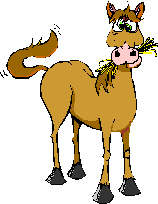BeetPulp Basics and How to Use Beet Pulp in Your Horse’s Ration Beet Pulp
Hmmm...this stuff ain'tso bad after all Beet Pulp is available
How Much to Feed A half pound (dry weightbefore soaking) of plain Beet Pulp makes a good low-carbohydrate carrier forsupplements. This would be in the range of a couple of handfuls of pellets or alittle more than half of a 1lb coffee can of shreds. Feeding a pound or two(dry weight) of Beet Pulp can help maintain weight and 3 to 4 pounds or morewill help with weight gain without increasing starch levels as grain does. Because of its high fibercontent, it can be used as 25-40% of the ration for horses who have difficultychewing. If replacing hay with beet pulp, figure around 1lb of beet pulp (dryweight before soaking) for each 1½ to 2 lbs of grass hay (2 lbs of beet pulpwould replace 3 to 4 lbs of hay). Beet Pulp shreds can befed without soaking - this has long been a practice at race tracks. Dry shredsare no more likely to cause choke than any other dry feed however most horses(and their humans) prefer them soaked, or at least moistened. Beet Pulp pellets tend tobe much harder than other pellets and it is strongly suggested they be fullysoaked. They will soften up in an hour or two depending on the brand andtemperature and will expand up to 10 times their original volume in 4-8 hours.It's really difficult to describe if you've never seen it. Caution - many reportbeet pulp getting "sour" if left too long, especially in warm weatheror if left in the sun during soaking. You can start soaking in the morning foran evening feed (or in the evening for a morning feed), preferably in theshade. Use a lot of water forsoaking. There should be an inch or two or water remaining on top after thebeet pulp is done soaking – this will be drained off before feeding. It cantake a little experimenting to see how much water you will need. Rinsing before soakingwill help remove dust and surface iron. Draining in a colander and rinsinguntil the water runs clear after soaking will help remove residual molasses –this is effective if you are unable to get plain (no molasses added) beet pulp.You can add fresh water back in if you want to feed a “soupier” version or ifyou horse needs more fluids. You can then addsupplements, salt and other "stuff" either top dressed or stirred in. Some horses willinitially turn up their nose at beet pulp and will take some acclimating. It canhelp to start with just a little beet pulp added to something they alreadylike, then gradually increase the beet pulp while decreasing the other feed tomake the transition. Many horses will just dive right in but if your horseneeds a taste tempter, you can try herbs or flavorings. Feeding beet pulp in flatfeed pans rather than wall feeders simplifies clean up - you can take the pansto a hose to rinse them out. The lowsides are also less apt to “concentrate” the new smells than a bucket orstraight sided feeder – this lets the horse use his natural curiosity toexplore his new feed without being overwhelmed by the strange smell and taste. Tips for Boarders Boarding your horsealways makes controlling your horse’s diet harder but many have found ways towork beet pulp into the routine. · If you can get to thebarn daily, soak the beet pulp at home or at work (a small cooler can work wellfor soaking and transporting). You can do this once a week or so and keep it inbaggies in your freezer, ready for a quick grab on your way out the door. · If the barn has arefrigerator, you can soak/drain/rinse the beet pulp at home and pack inindividual baggies to keep in the barn’s fridge. (For more than 3-4 days, itshould be kept in the freezer.) · While “soak/drain/rinse”is ideal to remove surface iron, dust and residual sugar, the draining/rinsingcould be skipped if your beet pulp is unmolassed and relatively dust free. · If the barn owner iswilling to help, make it easy for them. Pre-measure the beet pulp and your supplements into baggies, provide alarge closed bucket or other container to keep your stuff neat and together. Ifneeded, provide the bucket for soaking, a colander for draining, a metal sweatscraper for stirring. And be willing to offer paying a bit extra for thisservice. Beet pulp is not “needed”but can be a good alternative to bagged feeds and grain or as a substitute forsome of the hay ration (especially if you need to replace some high sugar/starchhay) and is well accepted by most horses. It doesn’t take long to get into aroutine and the benefits usually outweigh any inconvenience. References and more information Dairy One Feed Composition Library (nutritional values of feedstuffs based on thousands of samples) TheFamous Squirrel Story and The Myths and Realities of Beet Pulp (Susan Evans Garlinghouse, DVM - endurance rider, endurance vet) MORE DEBATE ON BEET PULP — IS IT TOXIC? (Lively debate on Liz Goldsmith's EQUINE Ink blog)
|
Articles & PDFs >

